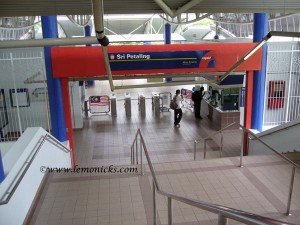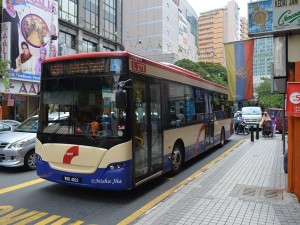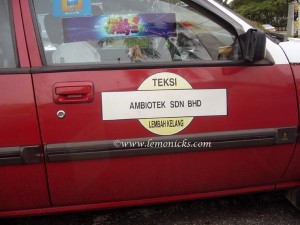Coming intoKuala Lumpurfrom any part of the world, the first thing people usually want to do is explore the city. Usually, the only way to get around in such situations as a tourist will be to either:
a) book a guided tour, or
b) use a hop-on-hop-off bus service, or
c) use public transportation.
Guided tours are privately owned, and they usually charge through the roof. The hop-on-hop-off tourist bus, though convenient for a first timer, will take you to so many places only. Also during Ramadan the operating hours are restricted from8:30amto 6:30pm. Standard adult ticket for non-Malaysians costs RM38.00 for 24 hours and RM65.00 for 48 hours.
So if you do a bit of preparation beforehand by looking up places of interest to visit in the city, the public transport system is more than adequate and should serve you well.
There are generally three ways of getting around the city, short of renting a vehicle yourself.
• You can take the train
• You can take the bus
• You can hail cabs

A train station in Kuala Lumpur.
The train system is managed by two companies, the KTM and the LRT. The KTM commuter trains are generally inter-city, and there is only one such line for local use. These trains have a frequency of 30 minutes, so be sure to plan a schedule accordingly! Also, they tend to be more crowded because of the low frequency.
The LRT is short for Light Rail Transit, and is an exclusively local transit system like metro trains in India. It has lines spreading out throughout the city starting radially from KL Sentral, the hub station of the city. Recently, the LRT stations were revamped so that you can change lines between different LRT trains within the station after buying a ticket. This makes travel to different parts of the city much more convenient. Masjid Jamek is one such major interchange station in Kuala Lumpur where you change LRT trains to catch trains for other lines. Indian examples are Dadar in Mumbai or Rajiv Chowk in Delhi. Here is a short video of LRT which I took on one of my previous visits.
Third in the train list is monorail. The KL Monorail is an intracity public transit system that links many key destinations withinKuala Lumpur. It passes through major hotels, central commercial, employment and shopping district in the city. You can buy your MyRapid Card or single journey tokens at any LRT or Monorail station. Tokens can be purchased from the Ticket Vending Machines (TVM) at all LRT and Monorail stations.
Here are a few notable train stations to keep in mind:
• Bukit Bintang (for going to the Bukit Bintang area where there are numerous malls and Arab Street)
• Imbi (this monorail station opens directly into Berjaya Times Square)
• KLCC (this stop opens into Suria KLCC, the mall on top of which are the Petronas Twin Towers)
• Masjid Jamek (to explore theMerdeka Squareregion and Little India)
• Plaza Rakyat (this is the nearest stop to the Puduraya bus station, and is within walking distance to Petaling Street, or as it’s generally referred to by tourists, Chinatown)
• Mid Valley (this stop is on the KTM line, so you will have to travel to KL Sentral, and switch to the KTM line)

A RapidKL bus.
The Bus network is pretty good too. There are basically two networks.
• One is provided by private operators; I guess it is called the metrobus. However, I find that this bus service is less frequented by tourists and used more by locals. They are all aircon and quite comfortable. If you do use this service do ask around to find out which bus goes where.
• The other set of buses are the feeder services run by Rapid KL. They take you to prominent points from the main metro stations. Now-a-days you can buy a card that is valid on both the LRT and Rapid KL. This is called Rapidpass Integrasi and can be bought for 1, 3, 7, 15 or 30 days number of days. The price starts from just RM10 for a single day. This is probably the most useful pass which affords unlimited travel on the metro and Rapid KL Bus network.
• Of course there are other networks like the shuttle bus service from the airports and the intercity buses.

A Teksi (taxi) in Kuala Lumpur.
The public transportation is extensive, but if you plan on travelling late at night, or if the place you want to visit is not on the network, you can always hail a cab to take you there. There are a multitude of taxi companies, but broadly there are two kinds of taxis available to the public; the basic service, and the executive taxis. Executive taxis are blue in colour, and are roomier. Compared to other means of transport, cabs are not cheap, and the minimum fare will set you back by RM 3 (RM 6 if it is an executive taxi), but it is the most convenient way to travel. You can also go to the nearest bus or train stop to your destination and hail a cab from there to save some money. If the traffic is not busy, cabs will usually get you to your destination faster than train and bus travel.
On the date of writing 1 Malysian Ringitt (RM) was approximately Indian Rupees 17.50.
